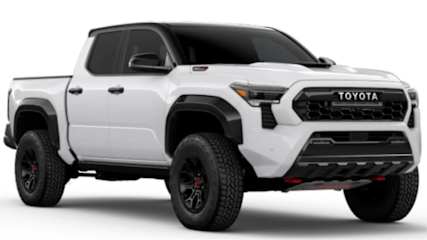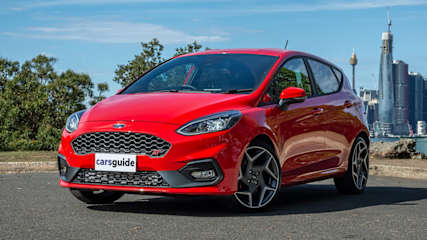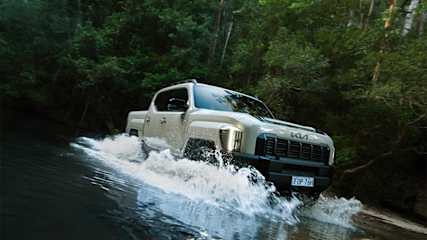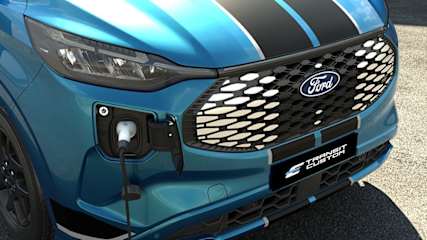1971 Ford F250 Reviews
You'll find all our 1971 Ford F250 reviews right here. 1971 Ford F250 prices range from for the F250 to for the F250 .
Our reviews offer detailed analysis of the 's features, design, practicality, fuel consumption, engine and transmission, safety, ownership and what it's like to drive.
The most recent reviews sit up the top of the page, but if you're looking for an older model year or shopping for a used car, scroll down to find Ford dating back as far as 1970.
Or, if you just want to read the latest news about the Ford F250, you'll find it all here.
Ford Reviews and News

The new Toyota HiLux we should get! Here are four reasons why the Toyota Tacoma-based Toyota HiLux won't be bothering the Ford Ranger, BYD Shark 6 and other utes in Australia ... and one reason why it still might!
Read the article
By Byron Mathioudakis · 11 May 2025
Where on earth is the Toyota Tacoma for Australia?Designed and developed expressly for the North American market, the series has served for over 30 years as the slightly larger and more comfortable cousin to the venerable Toyota HiLux.In fact, the two medium-sized utes were closely related until very recently, even as the Tacoma grew larger and more sophisticated over three generations, where it became the best-selling vehicle in its pick-up segment in the United States – a position held since 2004.Unveiled in 2023, the latest version prompted a high level of anticipation from industry analysts, since it was also expected to become the replacement for the eighth-gen HiLux, which celebrates its 10 anniversary this month.After all, the Tacoma’s timing was spot-on, with the newly-redesigned Ford Ranger ending the Toyota ute’s seven-year reign at the top of the Australian sales charts that same year (and hit number one again in 2024).It doesn’t take too much to figure out why people remain excited about the prospect of a HiLux-badged Tacoma for our market.Key attributes include a formidable presence brought about by its chunky styling, a vast array of grades including a Raptor-aping TRD Pro, huge interior space, sizeable load area, massive step up in safety technology and the availability of a hybrid powertrain option.The Tacoma trails Australia’s 3500kg braked towing capacity maximum yardstick by around 500kg, based on corresponding Canadian figures.That would probably change for our market, especially when you consider that today’s Tacoma is based on the same Toyota New Global Architecture – Frame (TNGA-F) body-on-frame “truck” platform that also underpins the J300 LandCruiser and J250 Prado 4WD SUVs.It is that connection that prompted much speculation over when – rather than if – the Tacoma would arrive in Australia, albeit wearing HiLux badges and possibly having Thai sourcing. After all, if they’re that closely related, wouldn’t they have interchangeable parts with models already offered in this market?As it turns out, Toyota will instead offer three distinctly different medium-sized utes – and it seems Australia will again miss out on the Tacoma after all… or at least, for now.Though unconfirmed officially, we hear from an internal source that a facelifted version of the existing, decade-old Mk8 HiLux will spearhead Toyota’s fight against the Ranger, BYD Shark 6 and co. from next year in Australia.About the only part of the Tacoma – which will remain North American only for the time being – we may see is a variation of its 2.4-litre i-Force turbo-petrol/electric hybrid powertrain, as it has been rumoured to be added to the HiLux facelift, as Toyota Australia starts its move away from diesel.Finally, as outlined previously, Europe, Japan and other lower-carbon regions are set to score the production version of the EPU (Electric Pick-Up) Concept Ute electric vehicle from the 2023 Tokyo Mobility show, though that’s also mooted for Australia too, as a flagship HiLux EV.So, what’s holding the Tacoma back for us?Mainly, it is only produced in Mexico, with annual capacity of around 250,000. And that’s about how many are soaked up in North America alone.Secondly – and this is a major reason – the Tacoma is only currently manufactured in left-hand drive (LHD) guise. And changing that makes no business sense.Typically, engineering for right-hand drive (RHD) in any vehicle program can add hundreds of millions of dollars to costs, and that appears not to have happened in this case. And it's not likely to in the future.Why? Even if Toyota could sell over 50,000 utes annually to match HiLux’s efforts last year in Australia – and that would possibly make us the fictional RHD Tacoma's largest market globally – that’s not nearly enough production volume to recoup development costs.That was reportedly one of the driving forces behind General Motors killing Holden barely two years after local manufacturing ceased in 2017, as there just wasn’t enough volume to justify the expense of changing LHD vehicles over to RHD for Australia. Even for a colossus like Toyota.Additionally, while the UK is another big RHD ute market for the brand, shifting around 30,000 HiLuxes last year, that's still not enough volume, while the vast majority of South African and Thai ute sales - the two remaining big RHD countries – are for more-affordable and lower-spec models. And cheap is not what any TNGA-F vehicle is designed to be.That’s probably the reason why the Tacoma is not earmarked to be built in Thailand, for now anyway. The existing HiLux fills that role far better.Thirdly, should it be green lit for RHD, the Tacoma would also be too expensive even in Australia, anyway, given its Mexican sourcing.This means the cheapest grade would probably cost a lot more than the current most expensive HiLux out of Thailand does. Which, by the way, is also where the Ranger, Isuzu D-Max, Mazda BT-50, Nissan Navara and Mitsubishi Triton also hail from, while the Shark 6, GWM Cannon, LDV Terron 9 and others from China cost even less for what they offer.Tacoma would have no hope matching their prices. The upshot here is that achieving something close to the current HiLux's 50,000 sales annually in Australia would be wildly optimistic as a result.Lastly, with Tacoma sales in the first quarter of 2025 up nearly 180 per cent year-on-year in the USA, there is no incentive for Toyota to compromise production capacity to accommodate the relatively small volume required for Australia.Of course, this could change with the US federal government’s tariffs on non-US made products, that might lead to big price increases for the Tacoma in its main market.While still highly unlikely, that might open the door for RHD exports should US Tacoma sales consequently collapse, though these are still early days.That’s a long shot, and it’s fair to assume that the only way Australians might be able to buy a reasonably-priced Tacoma is if Toyota decides to add production to Thailand, or some other lower-cost base than Mexico. Or follow the larger Tundra ute’s example by having it remanufactured from LHD to RHD in Melbourne.So, no Tacoma-based HiLux, then.Which is a shame, as a ute version of the latest Prado – which what the latest, N400 model essentially is, complete with an i-Force petrol-electric hybrid powertrain – would sound like the HiLux that Toyota should be offering to its fanatically loyal Australian customer base.Do you agree?

Ford could bring back famous axed car: Tie-up with Volkswagen could lead to the return of iconic hatchback as an electric car: Reports
Read the article
By Samuel Irvine · 06 May 2025
Two years after it was retired to the hatchback hall of fame, the iconic Ford Fiesta could return as a rebadged Volkswagen – and an EV.
.jpg)
Diesel dominance! Utes like the Ford Ranger, Toyota HiLux and Isuzu D-Max and SUVs like the Ford Everest and Toyota LandCruiser stage major diesel comeback as plug-in sales plummet in April
Read the article
By Andrew Chesterton · 05 May 2025
Diesel powertrains mounted a major comeback in April, dominating the country's best-seller lists as plug-in hybrid powertrains suffer as FBT exemptions expire.
.jpg)
Unmarked police cars Australia: How to spot an undercover cop car
Read the article
By Stephen Corby · 05 May 2025
There are some states where the very existence of unmarked police cars seems almost as illogical as it is cruel, while in others, like Victoria, it’s a surprise that every second vehicle isn’t a cop car in disguise.
.jpg)
Ford Ranger ute and Everest SUV hit with urgent recall
Read the article
By Samuel Irvine · 01 May 2025
Ford has recalled 13,490 examples of its popular Ranger ute and Everest SUV built between 2022 and 2025 due to a manufacturing defect impacting vehicles fitted with Ford’s 3.0-litre turbodiesel V6 engine.
.jpg)
Is the Ford Everest Super Duty happening? Could the beefed-up Ford Ranger variant work as an SUV with GMC Yukon Denali-beating towing power?
Read the article
By Byron Mathioudakis · 27 Apr 2025
Hot on the heels of the Ford Ranger Super Duty, is a Super Duty version of the Everest in the pipeline?With the upcoming GMC Yukon Denali the new SUV towing champion in Australia at 3628kg – pipping out the Toyota LandCruiser, Isuzu MU-X, Ineos Grenadier, Toyota Prado and regular Everest amongst others by just 128kg – a new high watermark has been set.In contrast, the newly-announced Ranger Super Duty breaks new ground among medium-sized utes by offering a 4500kg braked towing capacity, suggesting that an Everest Super Duty may have the might to approach that, given its kinship to the Ranger.When asked if a more rugged, go-anywhere workhorse version of the Everest was under consideration, Ford Australia President and CEO Andrew Birkic did not dismiss the notion.“I don't think we've done that yet,” he told the media at Ford Australia’s Centennial anniversary in Melbourne earlier this month.“But you never say never.”Other Ford engineers were less forthcoming, but suggested that the Everest’s transformation from ride/handling/refinement-focused family SUV to a Super Duty-style 4x4 workhorse would be an “extremely challenging” task.While both the Ranger and Everest share the same T6.2 ladder-frame platform, they differ in the mid and rear chassis sections, chiefly to accommodate the latter’s second and third row occupant structures, as well as its coil-sprung rear suspension set-up.With beefier springs and dampers, as well as a solid-axle leaf-sprung rear suspension design out back, the Ranger was already better suited for its transformation to Super Duty compared to the Everest.It’s also worth keeping in mind that a large portion of the Ranger Super Duty’s expected consumer base will be from the emergency services, forestry, mining and agricultural sectors, necessitating the ute’s cab-chassis flexibility.Still, Ford is in the business of making money in Australia, and so if there is demand for an Everest Super Duty, it will investigate that from a business case perspective.Obviously, being the first ex-factory mid-sized ute of its type anywhere in the world to offer a 4500kg braked towing capacity, even the Blue Oval bosses have no real idea how the market will react to it.Finally, at the same Ford Centenary event, Ford Motor Company Chief Executive, William Clay Ford Jr., did extol the Australian-based T6.2 team’s unique capabilities and talents, so who knows what may come next?“We have so much opportunity in front of us, and you know, we've made Australia a Centre of Excellence for Ford,” the brand’s global number one exec said.“They've done a great job. Just look at the sales results of Ranger and Everest… and Ranger is now (sold in) 180 different countries, which is incredible.“So, yeah, this is a great team here, and they will have opportunity in the future.“This is a unique market, as you know, better than I do, in terms of the requirements, and that's why it's interesting. On Super Duty, there was a real hesitance in Dearborn to put the Super Duty name on something other than the F-Series (full-sized truck).“But (Ford Australia) convinced the management team, us, to extend the Super Duty, because they knew the engineering team here, but as importantly, the kind of duty cycles you have here really warranted the Super Duty name.”

2025 Kia Tasman price and specs comparison: How does the bold new ute shape up against the popular Ford Ranger, Toyota HiLux and Isuzu D-Max?
Read the article
By Samuel Irvine · 25 Apr 2025
Kia Australia has some big expectations for its incoming Tasman ute. Most notable is the brand's aim of off-loading 20,000 units in its first full year, the equivalent to one quarter of the Tasman’s projected global sales.To do so in a shrinking ute market, it will need to lure Australian buyers away from traditional staples in Ford, Toyota and Isuzu while fighting off an increasing cohort of budget Chinese rivals such as BYD, GWM and JAC.Achieving that will be no easy feat and require the Tasman come competitively on the basics: grunt, payload, towing, tech, and arguably most important of all, price.So, does it? We’ve put the Tasman's top-grade head-to-head against some of Australia’s most popular ute models in an on-paper comparison designed to give you the best run-down on the all-new model before we've even taken it for a test drive.Starting with ground clearance, at 252mm, the Tasman exceeds its rivals by a minimum of 12mm. You could argue it's a relatively paltry difference, but 4WD enthusiasts would argue every millimetre counts when you're traversing rough terrain.Approach and departure angles is another area where the Tasman shines. At 32.2-degree approach and 26.2-degree departure, the Tasman shapes up as a symphony of well thought out proportions, something that will, once again, make it appealing to the four-wheel driving class.As an additional note, Kia claims to have "best-in-class" tub volume at 1173 litres, which sounds unusual given it doesn't have the largest tub dimensions in this class. Rather, its tub width and length are smaller than the Ford Ranger Wildtrak and Toyota HiLux Rogue. Further enquiries with Kia found that its best-in-class claim is according to VDA specifications, a commonly used European cargo space measuring guide. Ford, meanwhile, claims a tub volume of 1233-litres on the Wildtrak (a whole 60 litres more), though it's unclear what measurement guide the figure is based on.If its raw torque and power you're after, prospective buyers may be a little disappointed with the Tasman's outputs – at least on paper.But don't let the figures trick you into thinking its not a capable ute. In fact, it leads all of its rivals on payload, while delivering benchmark 3500kg towing; something the new plug-in hybrid BYD Shark 6 (321kW/650Nm) couldn't conquer.Kia said the decision to offer a 2.2-litre turbo-diesel four-cylinder engine, which falls 30kW/159Nm short of its most powerful rival (the V6 Ford Ranger Wildtrak), was based on the brand's decision to comply with Australia's New Vehicle Efficiency Standards (NVES). The scheme penalises carmakers who exceed government-mandated carbon emissions limits.While Kia is yet to officially release homologated emissions data on the Tasman, its relatively strong fuel consumption of 7.6 litres/100km suggests it will duck under the targets many of its rivals will fall victim to.This is one area where the Tasman decisively leads the segment, particularly in terms of tech and comfort. It carries twin 12.3-inch screens for multimedia and the digital driver's display, with a 5.0-inch touch monitor for climate controls wedged in-between.There's wireless Apple CarPlay and Android Auto connectivity, digital radio, wireless charging, quilted leather upholstery and intuitive features like a large folding-table mounted to the centre console.Kia claims the Tasman has "class-leading" headroom, shoulder room and second row legroom, which makes sense given it is the longest vehicle in its class. The Tasman also comes with an additional 33 litres of under seat storage.The Ranger Wildtrak's interior set-up comes the closest, with a 10.1-inch portrait-oriented touchscreen and an 8.0-inch digital driver's display. It carries wireless Apple CarPlay and Android Auto connectivity, too, as well as wireless charging and digital radio. Under seat storage is offered on the Wildtrak, however, Ford chooses not to quote a litre figure.The D-Max X-Terrain carries a smaller 9.0-inch multimedia touchscreen with wireless Apple CarPlay and Android Auto, along with an 8.0-inch digital driver's display. It misses out on wireless charging, though.The HiLux Rogue is well off the pace, providing only an 8.0-inch colour touchscreen with wired Apple CarPlay and Android Auto, no wireless charging pad and fewer clever storage spaces. Toyota is, however, set to upgrade this configuration next year when the new HiLux arrives.* All prices calculated before on-road costsPricing was one area where the Tasman was expected to spank the established competition, though its entry price of $42,990 before on-roads for the two-wheel drive S grade exceeds all its rivals by at least $6110.That likely comes down to higher production costs (the Tasman is built in South Korea, while its rivals are built in Thailand) and a more generous offering of standard features.By no means, however, is the Tasman exuberantly expensive, as evidenced by the X-Pro's mere $150 premium over the Wildtrak – a popular variant of Australia's most popular ute. But the success of budget Chinese brands, such as BYD, Chery, GWM and MG, in Australia has shown buyers are increasingly willing to prioritise value above all else, which could hurt the Tasman's sales prospects.Despite the conjecture online about the Kia Tasman's design, which does take a little getting used to, the Tasman is, by all means, a compelling package.It delivers and, in fact, exceeds the competition on several fundamentals, from ground clearance and approach/departure angles to payload, fuel efficiency, interior comfort and tech.That said, two key factors may not necessarily work in its favour - design and price. In a world where buyers are becoming increasingly cost-conscious, there may be a tendency to opt for more conventionally-styled budget rivals.As always, though, only time will tell whether the Tasman can live up to its maker's expectations.

Australia's first plug-in hybrid van arrives: 2025 Ford Transit Custom PHEV and EV price and specs detailed to take on Volkswagen Transporter and LDV eDeliver 7
Read the article
By Samuel Irvine · 24 Apr 2025
Australia’s van segment finally has its first plug-in hybrid: the 2025 Ford Transit Custom PHEV.

The Mitsubishi Magna at 40: how Aussie ingenuity changed the global face of family-sedan motoring and supercharged the Toyota Camry's rise to the top
Read the article
By Byron Mathioudakis · 20 Apr 2025
In nearly 140 years of the motor vehicle, history records only two Australian cars that truly left their mark on the world – even to this day.

Where is the 2026 Ford Everest PHEV? The update on the plug-in hybrid version of Australia's best-selling large SUV and Toyota Prado, Isuzu MU-X rival
Read the article
By Byron Mathioudakis · 20 Apr 2025
With the eagerly-anticipated Ford Ranger plug-in hybrid electric vehicle (PHEV) finally hitting showrooms in the middle of this year to give the BYD Shark 6 PHEV a run for its money, is that where this level of electrification development stops on the T6.2 platform?




